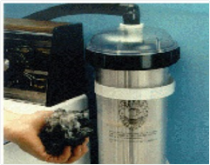Difference between revisions of "Practitioner's Tool / Determining Pretreatment Needs – Commercial laundry services"
From Akvopedia
m (Winona moved page Step 5: Determining Pretreatment Needs – Commercial laundry services to Practitioner's Tool / Planning and Promotions / Step 5: Determining Pretreatment Needs – Commercial laundry services without leaving a redirect) |
|||
| Line 5: | Line 5: | ||
If you wash laundry at your facility, it is in your best interest to install and maintain lint traps. Lint, like grease, can clog up your pipes and add to your septage hauling bills. It also makes electric equipment work harder, which costs you money! | If you wash laundry at your facility, it is in your best interest to install and maintain lint traps. Lint, like grease, can clog up your pipes and add to your septage hauling bills. It also makes electric equipment work harder, which costs you money! | ||
| − | ''[[ | + | ''[[Laundries|More information on laundries]]'' |
'''[[Step_6:_Determining_Pretreatment_Needs_–_Markets|Proceed to Step 6]]''' | '''[[Step_6:_Determining_Pretreatment_Needs_–_Markets|Proceed to Step 6]]''' | ||
[[Practitioner's Tool / Planning and Promotions|Back to Planning Page]] | [[Practitioner's Tool / Planning and Promotions|Back to Planning Page]] | ||
Revision as of 23:34, 22 September 2016
Hospitals, resorts and hotels often perform laundry washing on site. Commercial laundries should use lint traps to protect sewer lines and septic tanks from clogging. Lint is made up of fibers and particles of fabrics, which can accumulate and form clogs. Lint traps are easy to install and service and are very effective in removing lint and should also be considered for home use.
If you wash laundry at your facility, it is in your best interest to install and maintain lint traps. Lint, like grease, can clog up your pipes and add to your septage hauling bills. It also makes electric equipment work harder, which costs you money!

